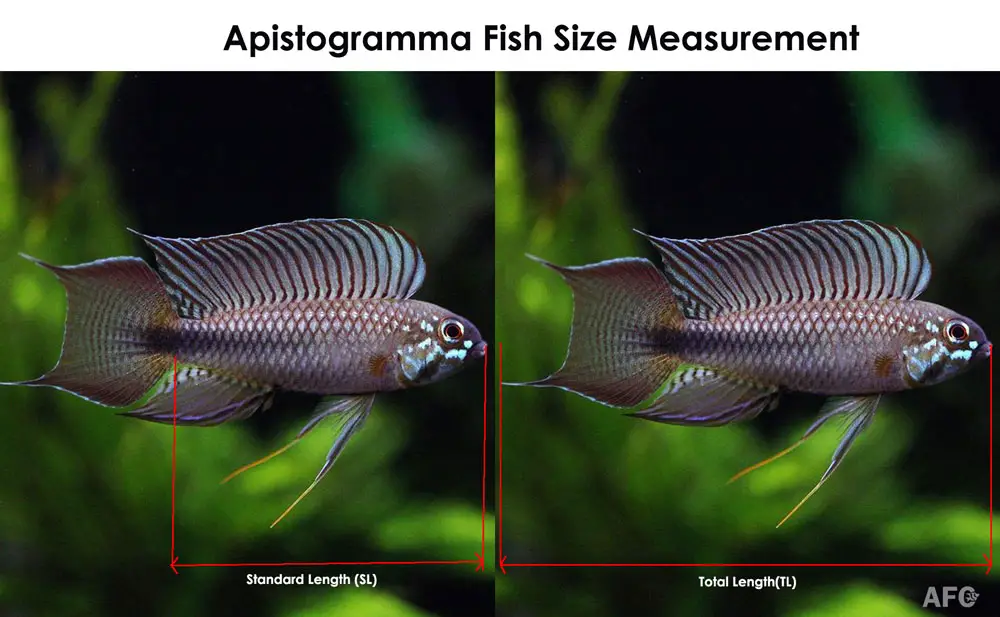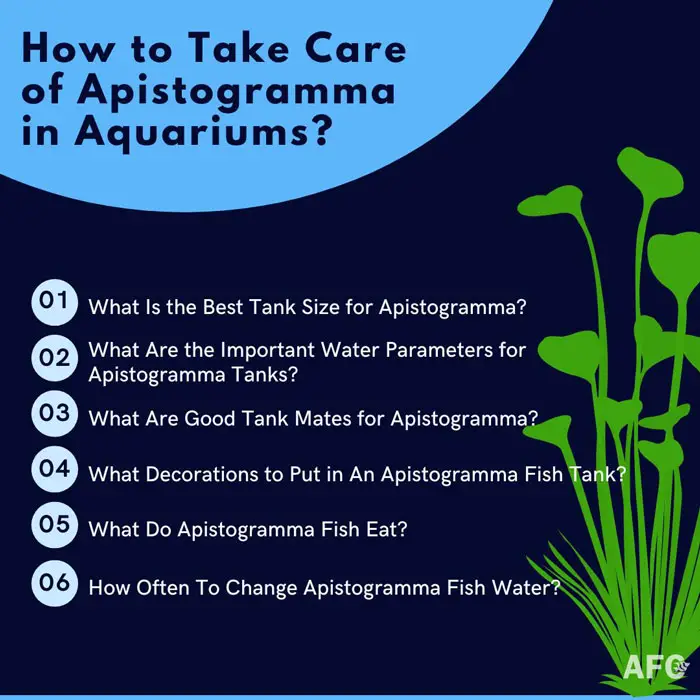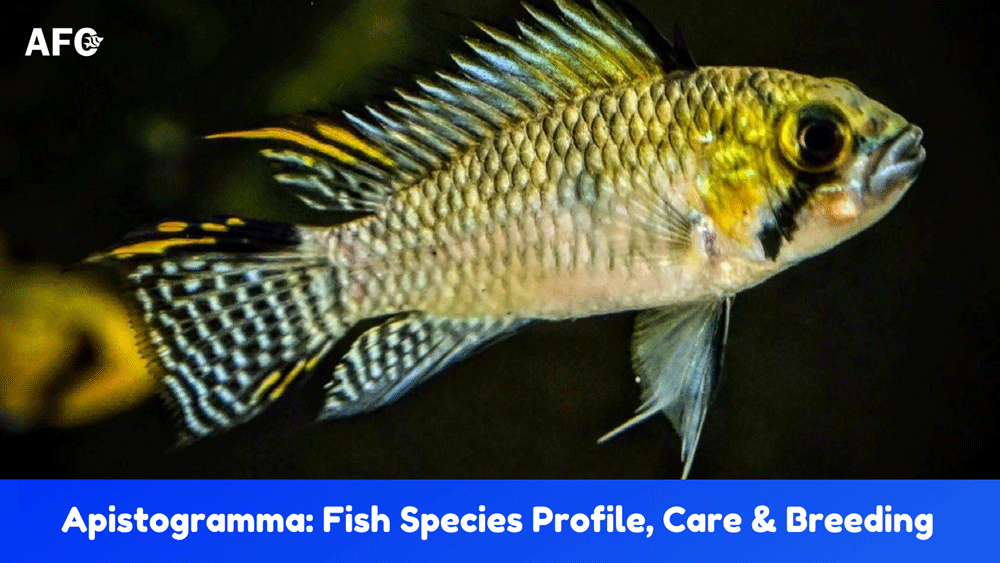Apistogramma is a species-rich group of small South American cichlids that display a wide range of colors, such as red, blue, yellow, and orange.
They can live up to 2 – 5 years when kept in optimal environments and have a semi-aggressive temperament, making them a colorful addition to small community freshwater aquariums.
While some types of Apistogramma are easy to take care of and suitable for beginner fish keepers, others do require special water quality parameters to optimize their growth potential and stimulate spawning.
What are Apistogramma Dwarf Cichlids?
Apistogramma Dwarf Cichlids originate from most of tropical South America east of the Andes. They are often referred to as “apisto” for short. The genus Apistogramma consists of 93 scientifically documented species so far, but over 400 undescribed species and forms have been reported, according to the article “A Description of Apistogramma Species-groups” by Mike Wise (2021).
The term “dwarf cichlid” is often colloquially used to describe any cichlid species that are smaller than 4 inches (10 cm) in the aquarium trade and hobby, as delineated by cichlid expert Dr. Paul Loiselle. It does not have a precise scientific definition within the taxonomy.
Going by this delineation, there are hundreds of dwarf cichlids from South America and Africa, with members of Apistogramma being the most popular and well-known.
How Big Do Apistogramma Dwarf Cichlids Get?
The average size of common Apistogramma fish is 3.0 to 3.5 inches (7.6 to 8.9 cm) in Total length (including the length of the tail fin). Some of the smallest Apistos measure less than 1 inch (2.5 cm), while the largest ones grow up to 4 inches (10 cm).
The largest and smallest Apistogramma species on the spectrum are often rare wild-caught specimens, which can be difficult to find in the hobby.
Depending on the species, most Apistos males grow bigger than females, with some species reaching up to twice their size. This is particularly true in polygamous species, where males develop extended filaments at the upper and lower ends of the tail fin, giving them a visually larger appearance.
What Is the Smallest Apistogramma?
Apistogramma angayuara is the smallest recorded species of Apistogramma, with the largest male measuring only 0.97 inches (2.47 cm) in standard length (excluding the length of the caudal fin), and the largest female measuring less than 0.89 inches (2.27 cm), according to a 2005 study conducted by Sven Kullander and Efrem J. G. Ferreira and published in the journal Neotropical Ichthyology entitled “Two new species of Apistogramma Regan (Teleostei: Cichlidae) from the Rio Trombetas, Pará State, Brazil.”
What Is the Largest Apistogramma?
The largest identified species of Apistogramma is Apistogramma kullanderi, which reaches a maximum size of 3.14 inches (7.97 cm) in standard length, as reported in a 2014 study entitled “A Titan among Dwarfs: Apistogramma kullanderi, New Species (Teleostei: Cichlidae)” by Henrique R. Varella and Mark H. Sabaj Pérez in the journal Ichthyological Exploration of Freshwaters.

What Are the Common Species of Apistogramma?
The five most commonly kept members of the Apistogramma family include the following species.
- A. cacatuoides (Cockatoo dwarf cichlid)
- A. agassizii (Agassizi’s dwarf cichlid)
- A. macmasteri (Red shoulder dwarf cichlid)
- A. borellii (Yellow dwarf cichlid)
- A. trifasciata (Three-striped dwarf cichlid)
These fish are known for their stunning colors like bright reds, blues, yellows, oranges, and and iridescent hues. Through selective breeding, many domestic Apistogramma strains have been developed with more vivid colors.
How Long Do Apistogramma Live?
The average lifespan of Apistogramma is 2-5 years in captivity, according to a 1991 statistical study of 7532 specimens from 23 different species by Dr. Uwe Römer. The study also found that A. cacatuoides had a comparatively longer life expectancy than other species, with an average lifespan of over 2 years.
Are Apistogramma Aggressive?
No, Apistogramma are classified as “semi-aggressive” fish, which means they occasionally chase or exhibit aggressive behaviors under certain circumstances. Most of their aggression occurs during the breeding season and does not result in injury.
Not all Apistogramma show the same level of aggression. Some species are more aggressive than others, and some individuals exhibit a greater level of aggression than average. In addition, captive-bred strains of Apistogramma generally display less aggression compared to their wild counterparts, and they do very well in a community freshwater aquarium.
The aggression of Apistogramma cichlids is an adaptive set of natural behaviors that allows them to compete against rivals for limited resources such as food, nests, or potential mates.
Scientific research supports the claim that the aggression level of fish is positively correlated with their social and mating systems. In general, Apistogramma species that employ opportunistic polygamy and monogamy mating strategies tend to be less aggressive than those species with strictly polygamous or monogamous systems.
What are The Least Aggressive Apistos?
The following are the top five least aggressive Apistogramma species.
- Apistogramma borellii
- Apistogramma alacrina
- Apistogrammoides pucallpaensis
- Apistogramma eunotus
- Apistogramma caetei
Apistogrammas species of the groups regani and alacrina in the regani Lineage are more peaceful than others, given their opportunistic polygamous mating strategy tendencies.
Are Apistogramma Community Fish?
Yes, many Apistogramma cichlids peacefully coexist in a properly arranged community tank alongside other fish that don’t share the same geographic origin, especially those staying in the middle and top of the tank.
Apistos available in fish stores are now almost always captive-bred. They are quite adaptable and do well with a range of water conditions as well as tank mates, making these fish a great choice for beginner cichlid owners.
These wild-caught Apistogramma typically don’t adjust well to home aquariums and would die in a community setup, particularly if the specimens were collected from the blackwater habitats of Rio Negro, Rio Uatumã, and Rio Madeira.
What are the Best Apistogramma Fish for a Community Tank?
These are 10 of the more popular community Apistogramma fish.
- A. borelli
- A. alacrina
- A. pucallpaensis
- A. eunotus
- A. macmasteri
- A. viejita
- A. trifasciata
- A. cacatuoides
- A. steindachneri
When mixing two different Apistogramma species in a community tank, avoid having more than one male of the same species or males with similar body shapes and fins. This will reduce competition and potential aggression among them. Also, keep them in a harem situation with two to three females per male to diffuse the persistent mating behavior of males.
Can You Keep a Single Apistogramma in Community Tanks?
Yes, you can definitely keep a single Apistogramma in a community tank if you don’t want to breed. A colorful male looks lovely in a small community aquarium with a background of green plants.
Are Apistogramma Good Cichlids for Beginners?
Yes, certain domestic strains of Apistogramma fish are excellent starter dwarf cichlids for beginners. Here’s why:
- Ideal size: They remain small and can comfortably live in smaller tanks.
- Hardy nature: They are resilient to allow for beginner mistakes.
- Community-friendly: They can peacefully coexist in community aquariums that new aquarists like to set up.
- Accessibility and affordability: They are reasonably priced and readily available.
What’s the Easiest Apistogramma to Take Care Of?
Apistogramma borellii and Apistogramma macmasteri are the two easiest Apisto species for beginners to take care of.
Apistogramma borellii, being smaller and more peaceful, is known for its adaptability to fluctuating water temperatures. Apistogramma macmasteri is more susceptible to disease in colder temperatures.
How to Take Care of Apistogramma in Aquariums?
To ensure the health and well-being of Apistogramma fish in an aquarium, consider all the following questions.
- What Is the Best Tank Size for Apistogramma?
- What Are the Important Water Parameters for Apistogramma Tanks?
- What Are Good Tank Mates for Apistogramma?
- What Decorations to Put in An Apistogramma Fish Tank?
- What Do Apistogramma Fish Eat?
- How Often To Change Apistogramma Fish Water?

What Is the Best Tank Size for Apistogramma?
Thanks to their compact size, the recommended tank size for Apistogramma fish is a 20-gallon (Long) aquarium, with dimensions of at least 30 inches (76.2 cm) in length and 12 inches (30 cm) in width. Nevertheless, experienced aquarists have successfully bred Apistogramma in aquariums as small as 10 gallons.
Apistos are bottom-dwelling fish that require ample bottom surface area to establish their territories. Therefore, it is advisable to choose a wider tank rather than a tall, narrow one.
In reality, the minimum tank size for Apistogramma varies based on the species and individual temperament. Polygamous and more aggressive Apistogramma species require larger tanks, while a few serial monogamous and peaceful species may thrive in relatively smaller environments.
A 2021 study found that female cichlids showed significantly more high-intensity aggression (bites and chases) when defending their nest sites and offspring.
Seasoned fishkeepers suggest giving each female Apistogramma a brood territory of approximately 12 inches (30 cm) in diameter. That’s why the 20 Gallon Long tank is most often recommended for beginners.
What Are the Important Water Parameters for Apistogramma Tanks?
There are five important water quality parameters to watch out for in an Apistogramma tank: pH, temperature, GH (general hardness), KH (carbonate hardness), and TDS(Total Dissolved Solids).
Apistogramma cichlids are native to tropical and subtropical regions of South America in the east of the Andes. The water in their natural habitat is typically soft, acidic, and has a very low conductivity due to decomposed organic matter.
What is a Good Level of pH in an Apistogramma Aquarium?
A slightly acidic to neutral pH ranging from 6.0 to 7.0 is considered suitable for domestic strains of Apistogramma cichlids, as they do not require soft and acidic water conditions to reproduce successfully.
To enhance vibrant colors and encourage spawning for Apistogramma species that are endemic to blackwater bodies, maintain a pH level aligned with their specific collection data. For example, A. elizabethae specimens were collected from Rio Negro tributaries with a pH of 4.7 (Römer 1998).
The sex ratio in Apistogramma is slightly influenced by the pH level, as demonstrated in a study on the environmental determination of sex in Apistogramma published in the Journal of Fish Biology by U. Römer and W. Beisenherz.
What Is the Recommended Water Temperature for Apistogramma Fish?
A range of 75° to 79°F (24°C to 26°C) is given as the best water temperature for Apistogramma fish in a home aquarium because this range best reflects their natural environment.
Furthermore, maintaining the water temperature within this range has been observed to increase the likelihood of achieving a balanced 50:50 male-to-female sex ratio among the fry, as stated in the same study above.
What GH Level is Ideal for Apistogramma?
An ideal GH (General Hardness) level for Apistogramma cichlids is between 0.5 and 3 dGH (10 ppm to 50 ppm). Do not exceed a GH of 8 dKH (140 ppm) in typical Apistogramma tanks.
GH measures the number of minerals dissolved in the water, mainly calcium and magnesium, that are present in most tap water. The higher the GH is, the harder the water.
Water hardness is important for Apistogramma breeders. When using an RO/DI (Reverse Osmosis/Deionization) unit to make soft water, keep in mind that Apistogramma fish need minerals for proper egg development and hatchability.
Can Apistogramma Be Kept in Hard Water?
Popular domestic Apistogramma strains can adapt to moderately hard water conditions (8-12 GH/140-210 ppm) as long as the water parameters remain stable. However, they may not reproduce as successfully in this range.
A. cacatuoides is the most adaptable species when it comes to water hardness, as it is found in neutral and moderately hard water habitats. Therefore, this species can thrive and reproduce in a wider range of GH levels than other Apistogramma species.
What Are Good Tank Mates for Apistogramma?
Here are some of the good Apistogramma tank mates.
- Freshwater Angelfish
- Geophagus cichlid
- Keyhole cichlid
- Checkerboard cichlid
- Pygmy cory
- Otocinclus catfish
- Neon tetras
- Cardinal tetras
- Marbled hatchetfish
- Harlequin rasbora
- Brown pencilfish
- Dwarf pencilfish
Because of their petite size, large predatory fish like Oscars and other large cichlid species must be avoided.
Additionally, certain fish species that compete for the bottom area, such as loaches, plecos, rams, and Geophagus, are not suitable tank buddies unless your aquarium is at least 40 gallons (150 L). In small tanks, choose those that stay in other parts of the water volume.
Tetras, Corydoras, and Plecos are notorious for potentially eating fish eggs/fry. If you wish to attempt to breed Apisto, surface-oriented dither fish are good tank companions.
What Decorations to Put in An Apistogramma Fish Tank?
Designing the Apistogramma tank with many boundary structures and providing each fish with its own territory is very important because the quality of the territory, comprising the substrate and nest site, directly impacts the level of aggression of Apistos.
Natural-looking aquarium decorations such as driftwood, leaf litter, rocks, and live plants should be added to provide hiding spots for the Apistogramma to closely resemble their natural habitat.
Do Apistogramma Need Caves?
Yes, Apistogramma do require caves for spawning and shelter. Typically, these caves have a small entrance that allows only the female Apistogramma to enter. Various materials, such as flower pots, coconut shells, driftwood, and PVC pipes, can create Apistogramma caves.
Do Apistogramma Need Plants?
Apistogramma do prefer having plenty of plants in the tank, especially floating plants that create dense shade. However, it is not always necessary.
In the wild, many Apistogramma species inhabit sandy riverbeds that lack aquatic plants. Instead, these areas are typically covered with fallen leaves, decaying wood, and other organic plant materials.
What is the Best Substrate for Apistogramma?
The best substrate for an Apistogramma tank is smooth sand. This type of aquarium substrate is commonly used because Apistogramma have a natural behavior of sifting through the substrate in search of food. Other substrate types, such as gravel and pebbles, may cause damage to the Apistogramma’s gills.
What Do Apistogramma Fish Eat?
In the wild, Apistogramma are omnivorous as well as micropredators by nature. Their sources of nutrition include small aquatic invertebrates, mosquito larvae, algae, and plant material.
In captivity, a mixture of sinking carnivore pellets and high-quality frozen or live meaty foods is a good staple diet for tank-raised Apistogramma fish. Wild-caught individuals are picky feeders that consume only live foods.
Newly hatched brine shrimp, glassworms, bloodworms, daphnia, and mosquito larvae have long been heralded as the best live food to feed Apistogramma. Ignore the Tubifex and blackworms for the sake of cleanliness.
How Often Should You Feed Apistogramma?
You should feed Apistogramma twice a day to meet their nutritional needs.
Since Apistos are bottom feeders, make sure that food is reaching them. Live food can be delivered to the bottom using tongs and lodged.
Do not overfeed these fish. Uneaten food can ultimately compromise the water quality they need. Remember, Apistogramma are dwarf cichlids with relatively small appetites.
How Often To Change Apistogramma Fish Water?
Performing a 25% water change weekly is sufficient to maintain the water quality of an Apistogramma tank.
Are Apistogramma Hard to Breed?
Yes, some species of Apistogramma are difficult to breed, primarily due to their need for very specific water quality parameters and suitable aquarium setups. However, spawning can be achieved with proper conditions, which vary depending on the species.
What Are the Easiest Apistogramma to Breed?
A. borelli, A. cacatuoides, and A. steindachneri are considered the easiest Apistogramma to breed.
A. borelli is known for its hardiness and durability, making it capable of spawning in a community setup alongside other peaceful fish. On the other hand, A. cacatuoides and A. steindachneri are not as picky when it comes to water hardness.
Which is the Most Prolific Apistogramma Species?
The A. steindachneri is regarded as the most prolific Apistogramma fish. The female can lay up to 250 eggs in a single spawn.
What Are The Differences Between Apistogramma Male versus Female?
The differences between Apistogramma males and females include size, fin shape, and coloration.
Most Apistogramma species demonstrate pronounced sexual dimorphism. Male Apistos tend to be larger and more robust, featuring long flowy fins that end with lappets. They also display more vivid colors and striking patterns. Females often show bright yellow with blackish markings during the breeding season.
Can Apistogramma Crossbreed?
Yes, crossbreeding can occur in certain rare cases among Apistogramma species.
Crossbreeding is uncommon among Apistogramma because the females are highly selective when choosing their mates during spawning. According to a study conducted by Dr. Uwe Römer, they typically disregard males from different geographical populations based on distinct markings specific to a particular regional area.
What Other South American Dwarf Cichlids Are Similar to Apistogramma?
The other popular small-sized South American cichlids similar to Apistogramma include the following.
- Mikrogeophagus ramirezi (Ram Cichlid)
- Mikrogeophagus altispinosus (Bolivian Ram Cichlid)
- Apistogrammoides pucallpaensis (T-Bar Cichlid)
- Dicrossus filamentosus (Checkerboard Cichlid)
- Laetacara curviceps (Dwarf Flag Cichlid)


